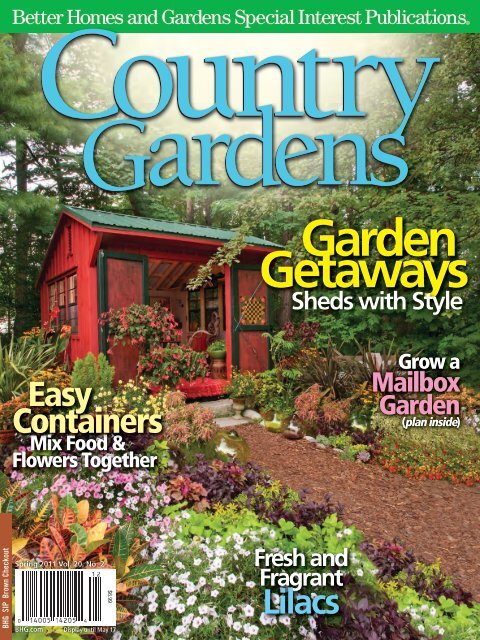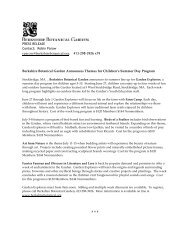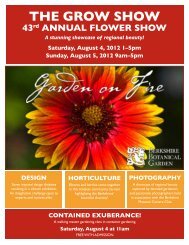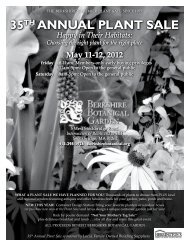BHG Country Gardens - Berkshire Botanical Garden
BHG Country Gardens - Berkshire Botanical Garden
BHG Country Gardens - Berkshire Botanical Garden
Create successful ePaper yourself
Turn your PDF publications into a flip-book with our unique Google optimized e-Paper software.
<strong>BHG</strong> SIP Brown Checkout<br />
Better Homes and <strong><strong>Garden</strong>s</strong> Special Interest Publications®<br />
Easy<br />
Containers<br />
Mix Food &<br />
Flowers Together<br />
Spring 2011 Vol. 20, No. 2<br />
<strong>BHG</strong>.com<br />
$4.99 $6.99<br />
U.S.<br />
Display until May 17<br />
<strong>Garden</strong><br />
Getaways<br />
Sheds with Style<br />
Fresh and<br />
Fragrant<br />
Lilacs<br />
®<br />
Grow a<br />
Mailbox<br />
<strong>Garden</strong><br />
(plan (plan (plan inside)
Rethinking<br />
The<br />
Humble<br />
<strong>Country</strong> <strong><strong>Garden</strong>s</strong> Spring 2011<br />
78<br />
Written and produced by Tovah Martin<br />
Photography by Kindra Clineff<br />
<strong>Garden</strong> Shed<br />
Knowing gardeners crave a room of their own, the <strong>Berkshire</strong><br />
<strong>Botanical</strong> <strong>Garden</strong> launched an exhibition showcasing garden sheds<br />
transformed into getaways.<br />
It began at a brainstorming session.<br />
Trustees of the <strong>Berkshire</strong> <strong>Botanical</strong><br />
<strong>Garden</strong> in Stockbridge, Massachusetts,<br />
were bouncing ideas back and forth<br />
for their summer 2010 exhibition,<br />
when the conversation turned into<br />
a boasting session about a trustee’s<br />
newest heartthrob—a garden shed.<br />
The structure was originally meant for<br />
tools, but it ended up retrofitted as a<br />
refuge with a view. Everyone in the<br />
room was drooling with envy when<br />
the eureka connection came—and<br />
the Living Stylishly in Nature: Re-<br />
Imagining the Humble <strong>Garden</strong> Shed<br />
exhibition was born.<br />
If ever there was a garden fixture<br />
with potential, it is the garden shed.<br />
Practically speaking, no garden can<br />
function without a place to store tools<br />
and other miscellaneous gardening<br />
paraphernalia. But the typical garden<br />
shed is begging to have a more<br />
thoughtfully designed exterior to<br />
elevate it to a glorious focal point; plus,<br />
the interior is poised to be put to work.<br />
Here’s a space that could be harnessed<br />
for so many purposes. Debra Prinzing,<br />
author of Stylish Sheds and Elegant<br />
Hideaways (Clarkson Potter, 2008),<br />
writes about the shed’s low point, post-<br />
World War II, when it was typically a<br />
corrugated unit ordered from a chain<br />
outlet. And she talks about a garden<br />
shed’s possibilities: “Now it could be<br />
an art studio, an office, a yoga retreat,<br />
a place to write ….” She also discusses<br />
how sheds have evolved. “The shed is
Right: Sarah Thorne pushes the spectrum, which<br />
is why her shed boasts vibrant shades rather than<br />
camouflage colors. With a kaliedoscopic garden<br />
for horticultural hermits, Peter’s picnic tables and<br />
fire pit at forest’s edge redefine hunkering down.<br />
Sylvan studio<br />
Sarah and Peter Thorne’s<br />
True Blue <strong>Berkshire</strong><br />
studio sports all the<br />
comforts of a little<br />
getaway in the woods.<br />
Not to forgo practicality,<br />
they fitted their refuge<br />
with Peter’s handhewn<br />
rustic furniture, a builtin<br />
bed, plus shelves for<br />
squirreling away nature’s<br />
treasures as well as pieces<br />
by local artisans from the<br />
couple’s shop, Thorne<br />
in West Stockbridge,<br />
Massachusetts.
Reading retreat<br />
Annie Selke of Pine Cone Hill<br />
in Pittsfield, Massachusetts,<br />
went straight to Stockholm for<br />
inspiration when designing<br />
this Swedish reading retreat.<br />
Not to strain the eyes in<br />
this bibliofile’s sanctuary,<br />
she raised the roof, added<br />
windows, and furnished the<br />
interior with soothing linen<br />
from her shop’s bedding line.<br />
part of America seeking solutions with the resources<br />
at hand,” she says. “Industrious Americans are<br />
repurposing what they have and doing it beautifully.”<br />
Traveling the country looking for sheds, she found<br />
that—beyond storage—they tended to take on<br />
another purpose: dining.<br />
The <strong>Berkshire</strong> <strong>Botanical</strong> <strong>Garden</strong>’s exhibition started<br />
with blank canvases—raw sheds sprinkled into the<br />
parklike grounds. As with a showhouse, selected<br />
designers were let loose to unleash their imaginations.<br />
Matthew Larkin, a local designer and topiary artist<br />
(and <strong>Berkshire</strong> <strong>Botanical</strong> <strong>Garden</strong> trustee) who curated<br />
the exhibition, had no preconceptions; there were no<br />
parameters or list of rules. Amazingly, the designers—<br />
local as well as from New York City—had only two<br />
weeks from delivery to opening night to work their<br />
Faux privy<br />
Architect Dick Bories and<br />
James Shearron of Bories &<br />
Shearron in New York, New<br />
York, wanted their shed to<br />
have function, resulting in<br />
the swankiest tongue-incheek<br />
homage to an 18th<br />
century privy imaginable. A<br />
full-length window frames<br />
the view beyond, flooding<br />
the interior with light.<br />
magic. In that short time, they emancipated each<br />
toolshed and gave it all the comfort and seduction<br />
of a living space. They let the light shine in, literally<br />
and figuratively, while opening up the views looking<br />
out. And they crafted spaces where gardeners might<br />
live intimately surrounded by nature. Leisure was the<br />
overarching theme. All of the sheds were designed for<br />
a slower pace of life and an embracing link with the<br />
outdoors. The exhibition included a blogging annex,<br />
a reading retreat, a playhouse, a glamorous privy, and<br />
a woodland artist’s studio.<br />
Throughout history, gardens have been studded<br />
with structures. Call it a temple, belvedere, folly,<br />
pavilion, gazebo, teahouse, playhouse, summerhouse,<br />
pool house, or whatever—a sanctuary in the garden<br />
raises the place to a higher pinnacle. Technically
Blogger’s den<br />
Designer Michael Devine<br />
figured that a garden<br />
blogger would wax poetic<br />
surrounded by muse but<br />
reclining in the lap of<br />
luxury. Mirrors seemingly<br />
expand the space as do<br />
Devine’s hand-printed<br />
fabric trimmings. When<br />
blogging after hours, a<br />
candelabra lights the way.<br />
speaking, there are subtle differences among the terms.<br />
A belvedere commands a view, a teahouse is inspired<br />
by Asian traditions, a temple has Greek roots, and a<br />
gazebo is open-sided. However, in modern parlance,<br />
the lines have blurred among designations.<br />
On the totem pole of structures, sheds have always<br />
taken up a utilitarian rung. But now the shed is getting<br />
its due respect and being explored for its full potential.<br />
Your shed can be anything from a sleeping bungalow<br />
to a guest cottage to a gaming room to a bachelor pad.<br />
Give it a sense of place, surround it with green, doll<br />
it up, fill it with whatever makes you comfortable, fit<br />
it with whatever feeds your fantasies—but above all,<br />
have fun with it. Sheds have been unplugged. ■<br />
<strong>Country</strong> <strong><strong>Garden</strong>s</strong> Spring 2011<br />
81<br />
A Shed of One’s Own<br />
Anyone who hankers for a shed should<br />
read Stylish Sheds and Elegant Hideaways<br />
(Clarkson Potter, 2008). While researching<br />
the book, author Debra Prinzing crisscrossed<br />
the country visiting 100 sheds and speaking<br />
with their proud owners. In the process, she<br />
came up with these rules that will streamline<br />
building your shed:<br />
Check local building codes and zoning<br />
guidelines. Many towns require permits<br />
before you construct a shed. It’s always wise<br />
to know the rules prior to breaking ground<br />
and beginning your project.<br />
Define your shed’s role. What function<br />
will your shed perform for you and your<br />
family? Consider expanding your shed’s job<br />
description beyond merely storing tools.<br />
Link with the landscape. Sheds can be a<br />
focal point and they also can camouflage<br />
an unsightly view. Make sure your structure<br />
enhances your landscape.<br />
Site the shed to suit your needs. When<br />
positioning your shed, think about sun if<br />
you’re growing plants nearby or shade<br />
if you want a place to cool down. Select a<br />
level location if possible rather than bringing<br />
in earth-moving equipment.<br />
Dress up the inside. Be creative with the<br />
interior decoration as well as the exterior<br />
design and color.<br />
Personalize it. Whether it’s bookshelves,<br />
plant shelves, windows, mirrors, stained<br />
glass, a chandelier, a bench, or other features<br />
that bring you bliss, incorporate those<br />
perks inside.<br />
Give yourself room to grow. Even if you plan<br />
to lounge in your shed, consider adding some<br />
work space—a counter for potting, storage<br />
cabinets, hooks for tools, etc. Let your shed<br />
do double duty.<br />
Add amenities. Think about wiring your shed<br />
for electricity. If you plan to grow plants,<br />
consider installing a drain in the floor or<br />
a sink for potting. Let your shed be the<br />
Shangri-la of your dreams.<br />
For more information, see Resources on page 102.








